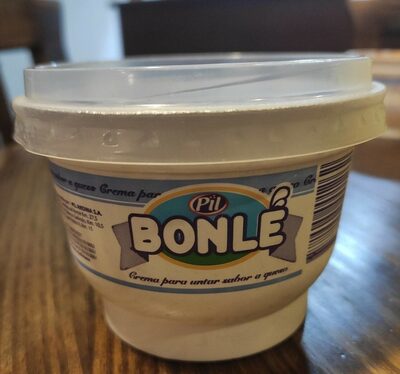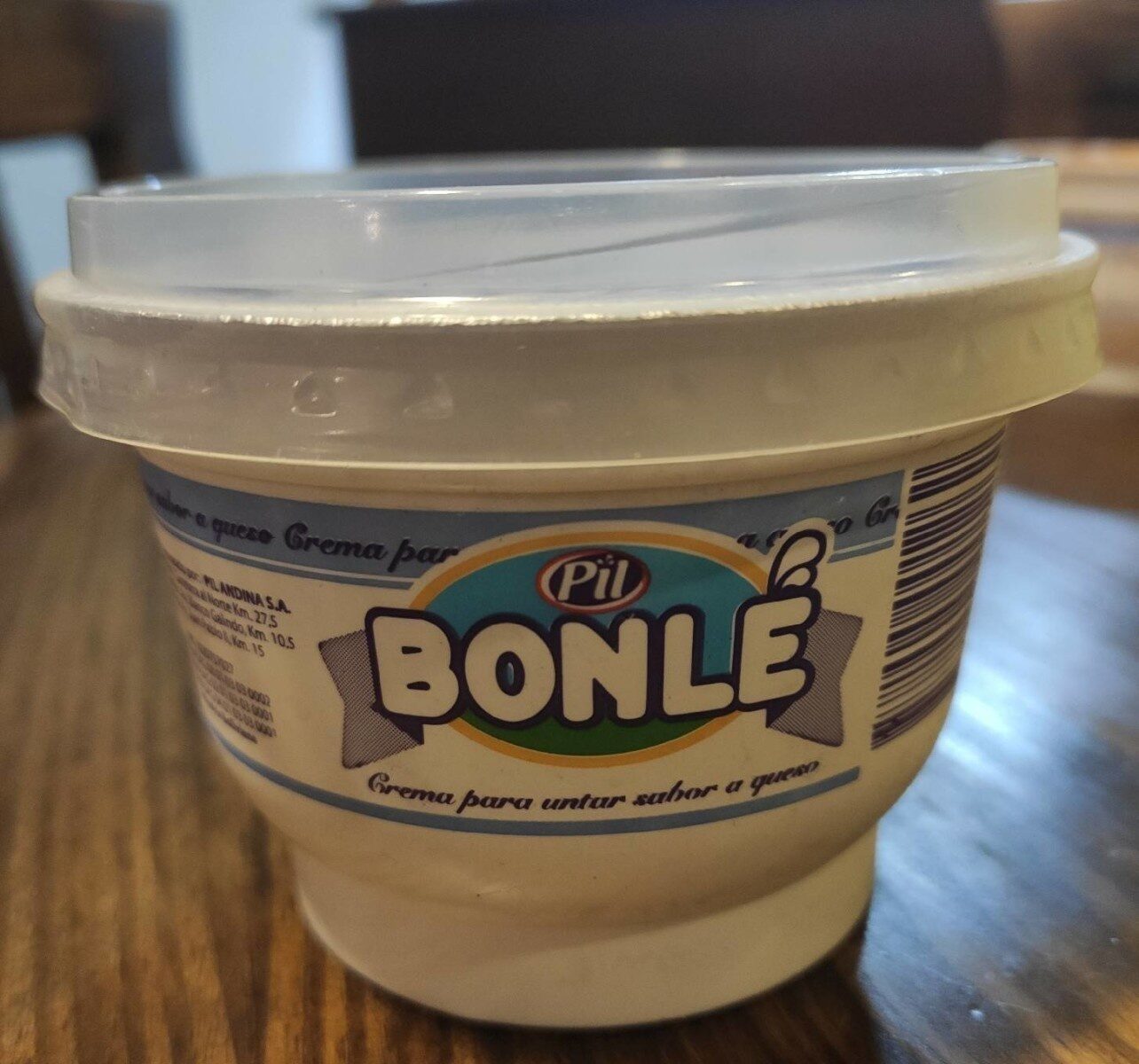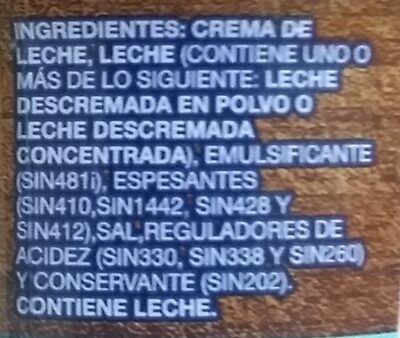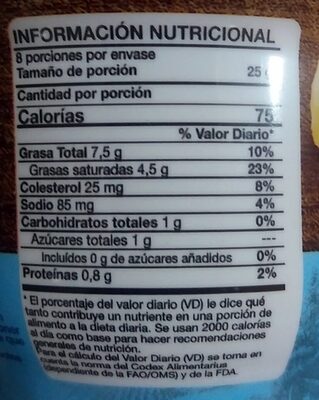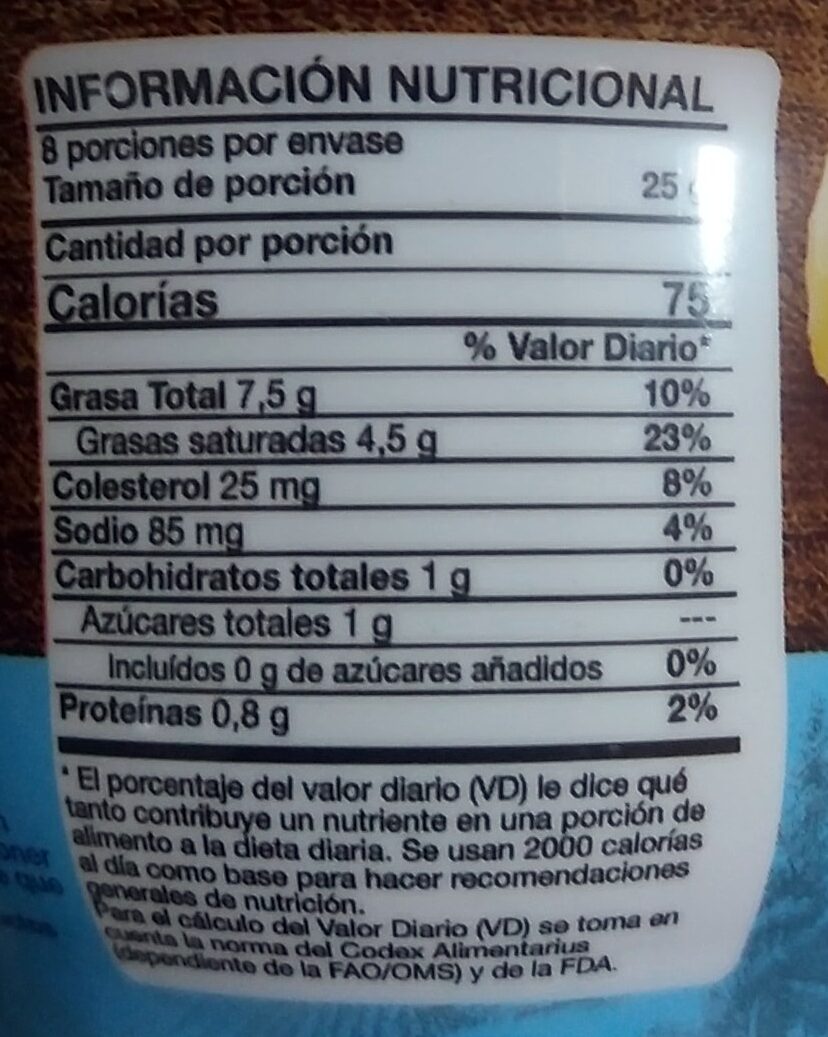Help us make food transparency the norm!
As a non-profit organization, we depend on your donations to continue informing consumers around the world about what they eat.
The food revolution starts with you!
Crema para Untar Bonlé - 200 g
Crema para Untar Bonlé - 200 g
Barcode: 7772905001262 (EAN / EAN-13)
Common name: crema para untar sabor a queso.
Quantity: 200 g
Packaging: Plastic, PS 6 - Polystyrene, Jar, Refrigerated
Brands: Bonlé, Pil, Gloria Bolivia
Categories: Dairies, Fermented foods, Fermented milk products, Breakfasts, Cheeses, Spreads, Salted spreads, Sweet spreads, Refrigerated foods, fr:Pâtes à tartiner, Cheese spreads
Labels, certifications, awards: es:Hecho en Bolivia
Origin of ingredients: Bolivia
Manufacturing or processing places: Santa Cruz, El Alto, La Paz, Quillacollo, Cochabamba, Bolivia
Traceability code: 080103030002, 020103030001, 040103030001
Link to the product page on the official site of the producer: https://pilandina.com.bo/producto/crema-...
Stores: Farmacorp, Bodegas Pil, Pil Express
Countries where sold: Bolivia
Matching with your preferences
Health
Ingredients
-
18 ingredients
: CREMA DE LECHE, LECHE (LECHE DESCREMADA EN POLVO, LECHE DESCREMADA CONCENTRADA), EMULSIFICANTE (SIN481i), ESPESANTES (SIN410, SIN1442, SIN428, SIN412), SAL, REGULADORES DE ACIDEZ (SIN330, SIN338, SIN260), CONSERVANTE (SIN202).Allergens: Milk
Food processing
-
Ultra processed foods
Elements that indicate the product is in the 4 - Ultra processed food and drink products group:
- Additive: E1442 - Hydroxypropyl distarch phosphate
- Additive: E410 - Locust bean gum
- Additive: E412 - Guar gum
- Additive: E428 - Gelatine
- Ingredient: Emulsifier
- Ingredient: Thickener
Food products are classified into 4 groups according to their degree of processing:
- Unprocessed or minimally processed foods
- Processed culinary ingredients
- Processed foods
- Ultra processed foods
The determination of the group is based on the category of the product and on the ingredients it contains.
Additives
-
E1442 - Hydroxypropyl distarch phosphate
Hydroxypropyl distarch phosphate: Hydroxypropyl distarch phosphate -HDP- is a modified resistant starch. It is currently used as a food additive -INS number 1442-. It is approved for use in the European Union -listed as E1442-, the United States, Australia, Taiwan, and New Zealand.Source: Wikipedia
-
E202 - Potassium sorbate
Potassium sorbate (E202) is a synthetic food preservative commonly used to extend the shelf life of various food products.
It works by inhibiting the growth of molds, yeast, and some bacteria, preventing spoilage. When added to foods, it helps maintain their freshness and quality.
Some studies have shown that when combined with nitrites, potassium sorbate have genotoxic activity in vitro. However, potassium sorbate is generally recognized as safe (GRAS) by regulatory authorities.
-
E260 - Acetic acid
Acetic acid: Acetic acid , systematically named ethanoic acid , is a colorless liquid organic compound with the chemical formula CH3COOH -also written as CH3CO2H or C2H4O2-. When undiluted, it is sometimes called glacial acetic acid. Vinegar is no less than 4% acetic acid by volume, making acetic acid the main component of vinegar apart from water. Acetic acid has a distinctive sour taste and pungent smell. In addition to household vinegar, it is mainly produced as a precursor to polyvinyl acetate and cellulose acetate. It is classified as a weak acid since it only partially dissociates in solution, but concentrated acetic acid is corrosive and can attack the skin. Acetic acid is the second simplest carboxylic acid -after formic acid-. It consists of a methyl group attached to a carboxyl group. It is an important chemical reagent and industrial chemical, used primarily in the production of cellulose acetate for photographic film, polyvinyl acetate for wood glue, and synthetic fibres and fabrics. In households, diluted acetic acid is often used in descaling agents. In the food industry, acetic acid is controlled by the food additive code E260 as an acidity regulator and as a condiment. In biochemistry, the acetyl group, derived from acetic acid, is fundamental to all forms of life. When bound to coenzyme A, it is central to the metabolism of carbohydrates and fats. The global demand for acetic acid is about 6.5 million metric tons per year -Mt/a-, of which approximately 1.5 Mt/a is met by recycling; the remainder is manufactured from methanol. Vinegar is mostly dilute acetic acid, often produced by fermentation and subsequent oxidation of ethanol.Source: Wikipedia
-
E330 - Citric acid
Citric acid is a natural organic acid found in citrus fruits such as lemons, oranges, and limes.
It is widely used in the food industry as a flavor enhancer, acidulant, and preservative due to its tart and refreshing taste.
Citric acid is safe for consumption when used in moderation and is considered a generally recognized as safe (GRAS) food additive by regulatory agencies worldwide.
-
E338 - Phosphoric acid
Phosphoric acid: Phosphoric acid -also known as orthophosphoric acid or phosphoricV acid- is a weak acid with the chemical formula H3PO4. Orthophosphoric acid refers to phosphoric acid, which is the IUPAC name for this compound. The prefix ortho- is used to distinguish the acid from related phosphoric acids, called polyphosphoric acids. Orthophosphoric acid is a non-toxic acid, which, when pure, is a solid at room temperature and pressure. The conjugate base of phosphoric acid is the dihydrogen phosphate ion, H2PO−4, which in turn has a conjugate base of hydrogen phosphate, HPO2−4, which has a conjugate base of phosphate, PO3−4. Phosphates are essential for life.The most common source of phosphoric acid is an 85% aqueous solution; such solutions are colourless, odourless, and non-volatile. The 85% solution is a syrupy liquid, but still pourable. Although phosphoric acid does not meet the strict definition of a strong acid, the 85% solution is acidic enough to be corrosive. Because of the high percentage of phosphoric acid in this reagent, at least some of the orthophosphoric acid is condensed into polyphosphoric acids; for the sake of labeling and simplicity, the 85% represents H3PO4 as if it were all in the ortho form. Dilute aqueous solutions of phosphoric acid exist in the ortho form.Source: Wikipedia
-
E410 - Locust bean gum
Locust bean gum: Locust bean gum -LBG, also known as carob gum, carob bean gum, carobin, E410- is a thickening agent and a gelling agent used in food technology.Source: Wikipedia
-
E412 - Guar gum
Guar gum (E412) is a natural food additive derived from guar beans.
This white, odorless powder is valued for its remarkable thickening and stabilizing properties, making it a common ingredient in various food products, including sauces, dressings, and ice creams.
When used in moderation, guar gum is considered safe for consumption, with no known adverse health effects.
Ingredients analysis
-
Palm oil free
No ingredients containing palm oil detected
Unrecognized ingredients: es:e481iSome ingredients could not be recognized.
We need your help!
You can help us recognize more ingredients and better analyze the list of ingredients for this product and others:
- Edit this product page to correct spelling mistakes in the ingredients list, and/or to remove ingredients in other languages and sentences that are not related to the ingredients.
- Add new entries, synonyms or translations to our multilingual lists of ingredients, ingredient processing methods, and labels.
If you would like to help, join the #ingredients channel on our Slack discussion space and/or learn about ingredients analysis on our wiki. Thank you!
-
Non-vegan
Non-vegan ingredients: Cream, Milk, Skimmed milk powder, Skimmed milk, E428Some ingredients could not be recognized.
We need your help!
You can help us recognize more ingredients and better analyze the list of ingredients for this product and others:
- Edit this product page to correct spelling mistakes in the ingredients list, and/or to remove ingredients in other languages and sentences that are not related to the ingredients.
- Add new entries, synonyms or translations to our multilingual lists of ingredients, ingredient processing methods, and labels.
If you would like to help, join the #ingredients channel on our Slack discussion space and/or learn about ingredients analysis on our wiki. Thank you!
-
Non-vegetarian
Non-vegetarian ingredients: E428Some ingredients could not be recognized.
We need your help!
You can help us recognize more ingredients and better analyze the list of ingredients for this product and others:
- Edit this product page to correct spelling mistakes in the ingredients list, and/or to remove ingredients in other languages and sentences that are not related to the ingredients.
- Add new entries, synonyms or translations to our multilingual lists of ingredients, ingredient processing methods, and labels.
If you would like to help, join the #ingredients channel on our Slack discussion space and/or learn about ingredients analysis on our wiki. Thank you!
-
Details of the analysis of the ingredients
We need your help!
Some ingredients could not be recognized.
We need your help!
You can help us recognize more ingredients and better analyze the list of ingredients for this product and others:
- Edit this product page to correct spelling mistakes in the ingredients list, and/or to remove ingredients in other languages and sentences that are not related to the ingredients.
- Add new entries, synonyms or translations to our multilingual lists of ingredients, ingredient processing methods, and labels.
If you would like to help, join the #ingredients channel on our Slack discussion space and/or learn about ingredients analysis on our wiki. Thank you!
: CREMA DE LECHE, LECHE (LECHE DESCREMADA EN POLVO, LECHE DESCREMADA), EMULSIFICANTE (e481i), ESPESANTES (e410, e1442, e428, e412), SAL, REGULADORES DE ACIDEZ (e330, e338, e260), CONSERVANTE (e202)- CREMA DE LECHE -> en:cream - vegan: no - vegetarian: yes - ciqual_food_code: 19402 - percent_min: 14.2857142857143 - percent_max: 100
- LECHE -> en:milk - vegan: no - vegetarian: yes - ciqual_proxy_food_code: 19051 - percent_min: 0 - percent_max: 50
- LECHE DESCREMADA EN POLVO -> en:skimmed-milk-powder - vegan: no - vegetarian: yes - ciqual_food_code: 19054 - percent_min: 0 - percent_max: 50
- LECHE DESCREMADA -> en:skimmed-milk - vegan: no - vegetarian: yes - ciqual_proxy_food_code: 19051 - percent_min: 0 - percent_max: 25
- EMULSIFICANTE -> en:emulsifier - percent_min: 0 - percent_max: 33.3333333333333
- e481i -> es:e481i - percent_min: 0 - percent_max: 33.3333333333333
- ESPESANTES -> en:thickener - percent_min: 0 - percent_max: 25
- e410 -> en:e410 - vegan: yes - vegetarian: yes - percent_min: 0 - percent_max: 25
- e1442 -> en:e1442 - vegan: yes - vegetarian: yes - percent_min: 0 - percent_max: 12.5
- e428 -> en:e428 - vegan: no - vegetarian: no - percent_min: 0 - percent_max: 8.33333333333333
- e412 -> en:e412 - vegan: yes - vegetarian: yes - percent_min: 0 - percent_max: 6.25
- SAL -> en:salt - vegan: yes - vegetarian: yes - ciqual_food_code: 11058 - percent_min: 0 - percent_max: 0.85
- REGULADORES DE ACIDEZ -> en:acidity-regulator - percent_min: 0 - percent_max: 0.85
- e330 -> en:e330 - vegan: yes - vegetarian: yes - percent_min: 0 - percent_max: 0.85
- e338 -> en:e338 - vegan: yes - vegetarian: yes - percent_min: 0 - percent_max: 0.425
- e260 -> en:e260 - vegan: yes - vegetarian: yes - percent_min: 0 - percent_max: 0.283333333333333
- CONSERVANTE -> en:preservative - percent_min: 0 - percent_max: 0.85
- e202 -> en:e202 - vegan: yes - vegetarian: yes - percent_min: 0 - percent_max: 0.85
Nutrition
-
Poor nutritional quality
⚠ ️Warning: the amount of fruits, vegetables and nuts is not specified on the label, it was estimated from the list of ingredients: 0This product is not considered a beverage for the calculation of the Nutri-Score.
Positive points: 1
- Proteins: 1 / 5 (value: 3.2, rounded value: 3.2)
- Fiber: 0 / 5 (value: 0, rounded value: 0)
- Fruits, vegetables, nuts, and colza/walnut/olive oils: 0 / 5 (value: 0, rounded value: 0)
Negative points: 16
- Energy: 3 / 10 (value: 1260, rounded value: 1260)
- Sugars: 0 / 10 (value: 4, rounded value: 4)
- Saturated fat: 10 / 10 (value: 18, rounded value: 18)
- Sodium: 3 / 10 (value: 340, rounded value: 340)
The points for proteins are counted because the product is in the cheeses category.
Nutritional score: (16 - 1)
Nutri-Score:
-
Nutrient levels
-
Fat in high quantity (30%)
What you need to know- A high consumption of fat, especially saturated fats, can raise cholesterol, which increases the risk of heart diseases.
Recommendation: Limit the consumption of fat and saturated fat- Choose products with lower fat and saturated fat content.
-
Saturated fat in high quantity (18%)
What you need to know- A high consumption of fat, especially saturated fats, can raise cholesterol, which increases the risk of heart diseases.
Recommendation: Limit the consumption of fat and saturated fat- Choose products with lower fat and saturated fat content.
-
Sugars in low quantity (4%)
What you need to know- A high consumption of sugar can cause weight gain and tooth decay. It also augments the risk of type 2 diabetes and cardio-vascular diseases.
Recommendation: Limit the consumption of sugar and sugary drinks- Sugary drinks (such as sodas, fruit beverages, and fruit juices and nectars) should be limited as much as possible (no more than 1 glass a day).
- Choose products with lower sugar content and reduce the consumption of products with added sugars.
-
Salt in moderate quantity (0.85%)
What you need to know- A high consumption of salt (or sodium) can cause raised blood pressure, which can increase the risk of heart disease and stroke.
- Many people who have high blood pressure do not know it, as there are often no symptoms.
- Most people consume too much salt (on average 9 to 12 grams per day), around twice the recommended maximum level of intake.
Recommendation: Limit the consumption of salt and salted food- Reduce the quantity of salt used when cooking, and don't salt again at the table.
- Limit the consumption of salty snacks and choose products with lower salt content.
-
-
Nutrition facts
Nutrition facts As sold
for 100 g / 100 mlAs sold
per serving (25 g)Compared to: Cheese spreads Energy 1,260 kj
(300 kcal)314 kj
(75 kcal)+35% Fat 30 g 7.5 g +56% Saturated fat 18 g 4.5 g +44% Cholesterol 100 mg 25 mg +103% Carbohydrates 4 g 1 g +7% Sugars 4 g 1 g +29% Added sugars 0 g 0 g Fiber - - Proteins 3.2 g 0.8 g -63% Salt 0.85 g 0.212 g -29% Calcium 104 mg 26 mg -67% Fruits‚ vegetables‚ nuts and rapeseed‚ walnut and olive oils (estimate from ingredients list analysis) 0 % 0 %
Environment
-
Eco-Score D - High environmental impact
⚠ ️Select a country in order to include the full impact of transportation.The Eco-Score is an experimental score that summarizes the environmental impacts of food products.→ The Eco-Score was initially developped for France and it is being extended to other European countries. The Eco-Score formula is subject to change as it is regularly improved to make it more precise and better suited to each country.Life cycle analysis
-
Average impact of products of the same category: C (Score: 56/100)
Category: Uncured soft cheese, spreadable, around 25% fat, in a tub
Category: Uncured soft cheese, spreadable, around 25% fat, in a tub
- PEF environmental score: 0.47 (the lower the score, the lower the impact)
- including impact on climate change: 4.98 kg CO2 eq/kg of product
Stage Impact Agriculture
83.3 %Processing
6.2 %Packaging
4.6 %Transportation
3.5 %Distribution
1.9 %Consumption
0.5 %
Bonuses and maluses
-
Origins of ingredients with a high impact
Malus: -5
Environmental policy: -5
Transportation: 0
Origin of the product and/or its ingredients % of ingredients Impact Bolivia 100 %High
-
Packaging with a medium impact
Malus: -14
Shape Material Recycling Impact 1 Jar PS 6 - Polystyrene Recycle High 1 Lid Plastic Recycle High 1 Label PVC 3 - Polyvinyl chloride Recycle High 1 Film Light aluminium Recycle Medium ⚠ ️ The information about the packaging of this product is not sufficiently precise (exact shapes and materials of all components of the packaging).⚠ ️ For a more precise calculation of the Eco-Score, you can modify the product page and add them.
If you are the manufacturer of this product, you can send us the information with our free platform for producers.
Eco-Score for this product
-
Impact for this product: D (Score: 37/100)
Product: Crema para Untar Bonlé - 200 g
Life cycle analysis score: 56
Sum of bonuses and maluses: -19
Final score: 37/100
-
Carbon footprint
-
Equal to driving 2.6 km in a petrol car
498 g CO² per 100g of product
The carbon emission figure comes from ADEME's Agribalyse database, for the category: Uncured soft cheese, spreadable, around 25% fat, in a tub (Source: ADEME Agribalyse Database)
Stage Impact Agriculture
84.0 %Processing
5.6 %Packaging
5.3 %Transportation
4.2 %Distribution
0.7 %Consumption
0.1 %
Packaging
-
Packaging with a medium impact
-
Packaging parts
1 x Jar (PS 6 - Polystyrene)
1 x Lid (Plastic)
1 x Label (PVC 3 - Polyvinyl chloride)
1 x Film (Aluminium)
-
Packaging materials
Material % Packaging weight Packaging weight per 100 g of product Plastic Metal Total
-
Transportation
-
Origins of ingredients
Origins of ingredients with a high impact
Origin of the product and/or its ingredients % of ingredients Impact Bolivia 100 %High
Report a problem
-
Incomplete or incorrect information?
Category, labels, ingredients, allergens, nutritional information, photos etc.
If the information does not match the information on the packaging, please complete or correct it. Open Food Facts is a collaborative database, and every contribution is useful for all.
Data sources
Product added on by kiliweb
Last edit of product page on by 5m4u9.
Product page also edited by ecoscore-impact-estimator, fix-salt-bot, jobertic, packbot, yuka.UjVzTkFwd3NuZU1Wd3RveG9rek53SXByNEk3elIzT3NKOFZQSUE9PQ, yuka.sY2b0xO6T85zoF3NwEKvlk1KDsvjkCrYCjLkxWiNysq_Ir3BUNNiy5bqaao.
